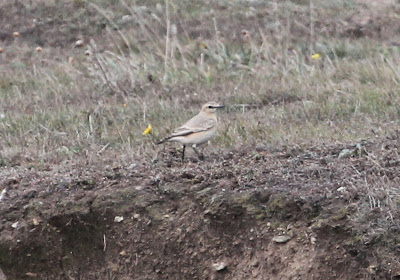Desperately trying to squeeze in a blog this evening, been
on a remote island for a week and I’m catching up on very important things such
as the Great British bake off which starts worryingly soon on the TV. But, I’m determined
to get a post out into the blogger world...
So, I’ve been at this place for a week and very nice it was
too.
The Island is owned and managed by the South & West
Wales Wildlife Trust and this year has been going through the motions of
re-establishing its former status as a bird observatory. It was the UK’s first
bird observatory but lost the status some time ago, so when Fred and myself heard
that ringers were needed to help with the ringing efforts on the Island we
opted to try Skokholm instead of the usual autumn Lundy trip which for the past
two years has been my island of choice. It turned out to be a pretty good
choice!
If we were able to order weather for a birding/ringing trip
in late September, easterly winds would be what we’d go for. The inability to
order weather often makes autumn trips somewhat varied but imagine our surprise
when the forecast had easterly winds all week!
The first morning, on our first trip round the heligoland
traps we discovered a Wryneck who somehow evaded capture until our third push
of the traps! They can really skulk when they want to! But this is what it
looked like when if finally made its way up the trap.
We also found a second bird whilst walking towards the trap.
I assumed it was the Wryneck which had previously been in the trap but that
theory was soon thrown out when the original bird was still next to its
favourite bush! The first bird stuck round all week and was re-trapped a few
days into the trip which allowed us to weigh it again. It wasn’t in the best of
health first time round but it had put on a couple of grams second time around,
so hopefully it will be able to carry on on its journey south soon.
After the Wrynecks on the first morning, expectations were
high for the afternoon but by dark nothing else had really happened. We had to
wait until the following days for something to emerge. It was this rather smart
(or just plain drab if your not a birdy person) Booted Warbler.
Steve, another visiting ringer watched the bird fly into the
mist net so our first views of it were in the hand but luckily this fella
showed well several times after release.
The next day the weather turned a bit damp and miserable so
reading books in the ringing hut was our chosen past time though we did
occasionally look up to watch this Red-breasted Flycatcher zipping about in
front of us.
Lost track of which days I’m now writing about but this one
was a good one. At the start of the week, a sweep stake of the rarest bird of
the week was started. Fred had put in Red-breasted Flycatcher, as did Rich, one
of the wardens. Before getting to the island I got Fred looking up on his fancy
Ipad thing, the ins and outs of Blyth’s Reed Warblers. I kept on a little about
this species and it was an obvious choice for the sweep stake. Fred and I briefly
stopped ringing for some lunch which was Steve's cue to walk into the kitchen
saying he’d just caught an un-streaked acro in one of the traps. Obviously,
Blyth’s Reed came straight to mind and this was confirmed when Rich took this
beast out of a bag!
This again is a bit of a birders bird as it’s another brown
thing. The next few photos get really nerdy but bear with me.
The open wing shows a clear emargination on the 4th
primary and even a slight emergination on the 5th. A very good
feature for Blyth’s Reed. Also the first primary falls short of the longest
primary covert.
The closed wing shows the short primary projection and the
emargination on the third primary falls short of the tips of the tertials. All good
features of Blyth’s Reed. Lots of the other measurements were taken by Rich,
all fitting in nicely with this species.
The legs show a greyishness about them, and that combined
with a stonking bill all pretty conclusively make this bird a Blyth’s Reed
Warbler. Only the 2nd Welsh record! Unlike the Booted Warbler, this
didn’t make an appearance after release but hey, you can’t have everything.
Must add a quick reference to Martin Cade’s Portland Obs website
which we were looking at prior to getting to the island picking out some
Blyth’s Reed features ready for one to show up...
We didn’t just catch brown rare birds on our trip. Some really
smart birds were also caught amongst lots of common migrants which was all great stuff for the islands records. I’ll finish up with these beauties.
Redstart (male)
Another Redstart (female)
Whinchat. What a stunner!
And finally, the sharp minds amongst you might notice that
the Great British bake off has now actually finished making the start of this
blog defunct. I had written most of this and then the program started so have
waited until now to publish the post. Thought I’d better mention it in case
anyone was wondering...










































